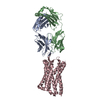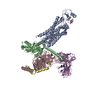+Search query
-Structure paper
| Title | Structural basis of antibody inhibition and chemokine activation of the human CC chemokine receptor 8. |
|---|---|
| Journal, issue, pages | Nat Commun, Vol. 14, Issue 1, Page 7940, Year 2023 |
| Publish date | Dec 1, 2023 |
 Authors Authors | Dawei Sun / Yonglian Sun / Eric Janezic / Tricia Zhou / Matthew Johnson / Caleigh Azumaya / Sigrid Noreng / Cecilia Chiu / Akiko Seki / Teresita L Arenzana / John M Nicoludis / Yongchang Shi / Baomei Wang / Hoangdung Ho / Prajakta Joshi / Christine Tam / Jian Payandeh / Laëtitia Comps-Agrar / Jianyong Wang / Sascha Rutz / James T Koerber / Matthieu Masureel /  |
| PubMed Abstract | The C-C motif chemokine receptor 8 (CCR8) is a class A G-protein coupled receptor that has emerged as a promising therapeutic target in cancer. Targeting CCR8 with an antibody has appeared to be an ...The C-C motif chemokine receptor 8 (CCR8) is a class A G-protein coupled receptor that has emerged as a promising therapeutic target in cancer. Targeting CCR8 with an antibody has appeared to be an attractive therapeutic approach, but the molecular basis for chemokine-mediated activation and antibody-mediated inhibition of CCR8 are not fully elucidated. Here, we obtain an antagonist antibody against human CCR8 and determine structures of CCR8 in complex with either the antibody or the endogenous agonist ligand CCL1. Our studies reveal characteristic antibody features allowing recognition of the CCR8 extracellular loops and CCL1-CCR8 interaction modes that are distinct from other chemokine receptor - ligand pairs. Informed by these structural insights, we demonstrate that CCL1 follows a two-step, two-site binding sequence to CCR8 and that antibody-mediated inhibition of CCL1 signaling can occur by preventing the second binding event. Together, our results provide a detailed structural and mechanistic framework of CCR8 activation and inhibition that expands our molecular understanding of chemokine - receptor interactions and offers insight into the development of therapeutic antibodies targeting chemokine GPCRs. |
 External links External links |  Nat Commun / Nat Commun /  PubMed:38040762 / PubMed:38040762 /  PubMed Central PubMed Central |
| Methods | EM (single particle) |
| Resolution | 2.76 - 3.1 Å |
| Structure data | EMDB-41370, PDB-8tlm:  EMDB-41827: Structure of a class A GPCR/agonist complex (focused map2)  EMDB-41828: Structure of a class A GPCR/agonist complex (focused map1) EMDB-41829, PDB-8u1u:  EMDB-41850: Structure of a class A GPCR/agonist complex (Consensus map) |
| Chemicals |  ChemComp-NAG: |
| Source |
|
 Keywords Keywords |  STRUCTURAL PROTEIN / GPCR Fab / STRUCTURAL PROTEIN / GPCR Fab /  GPCR / GPCR /  agonist agonist |
 Movie
Movie Controller
Controller Structure viewers
Structure viewers About Yorodumi Papers
About Yorodumi Papers












